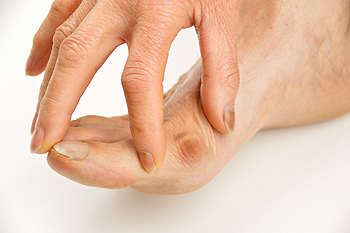Bunions May Develop for Several Reasons
Monday, 16 November 2020 00:00 There are several reasons why bunions may develop. These can include genetic factors, wearing shoes that do not fit correctly, a foot deformity, or from a medical condition like arthritis. A bunion is defined as a bone that protrudes from the joint in the big toe, and may cause severe pain and discomfort. Additional symptoms of a bunion can consist of swelling and redness surrounding the affected joint, and the toe may be difficult to move. After a proper diagnosis is made, which generally involves having an X-ray taken and a physical examination of the foot is performed, proper treatment can begin. Orthotics may be prescribed and it is beneficial to wear shoes that have low heels and a wide toe box. If your bunion is very painful or causing difficulty walking, it is strongly suggested that you are examined by a podiatrist.
There are several reasons why bunions may develop. These can include genetic factors, wearing shoes that do not fit correctly, a foot deformity, or from a medical condition like arthritis. A bunion is defined as a bone that protrudes from the joint in the big toe, and may cause severe pain and discomfort. Additional symptoms of a bunion can consist of swelling and redness surrounding the affected joint, and the toe may be difficult to move. After a proper diagnosis is made, which generally involves having an X-ray taken and a physical examination of the foot is performed, proper treatment can begin. Orthotics may be prescribed and it is beneficial to wear shoes that have low heels and a wide toe box. If your bunion is very painful or causing difficulty walking, it is strongly suggested that you are examined by a podiatrist.
If you are suffering from bunion pain, contact Brian D. Jackson, DPM of Neuhaus Foot and Ankle. Our doctor can provide the care you need to keep you pain-free and on your feet.
What Is a Bunion?
Bunions are painful bony bumps that usually develop on the inside of the foot at the joint of the big toe. As the deformity increases over time, it may become painful to walk and wear shoes. Women are more likely to exacerbate existing bunions since they often wear tight, narrow shoes that shift their toes together. Bunion pain can be relieved by wearing wider shoes with enough room for the toes.
Causes
- Genetics – some people inherit feet that are more prone to bunion development
- Inflammatory Conditions - rheumatoid arthritis and polio may cause bunion development
Symptoms
- Redness and inflammation
- Pain and tenderness
- Callus or corns on the bump
- Restricted motion in the big toe
In order to diagnose your bunion, your podiatrist may ask about your medical history, symptoms, and general health. Your doctor might also order an x-ray to take a closer look at your feet. Nonsurgical treatment options include orthotics, padding, icing, changes in footwear, and medication. If nonsurgical treatments don’t alleviate your bunion pain, surgery may be necessary.
If you have any questions, please feel free to contact one of our offices located in Columbia and Pulaski, TN . We offer the newest diagnostic and treatment technologies for all your foot care needs.







